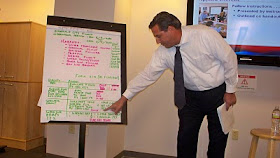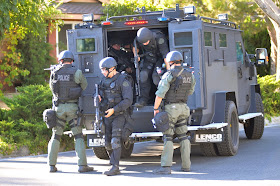
Karin wins with her 9:06 a.m. Tuesday guess "Officials tour Wrigley Mansion, circa 1958. Donated to COP after Mrs Wrigley's death as permanent headquarters for T O Roses."
In the photo above, Pasadena Mayor Ray G. Woods (left), Tournament of Roses Association Raymond A. Dorn and Chairman of the TofR Board Max Colwell admire a crystal chandelier during a tour of the Wrigley Mansion on Oct. 13, 1959.
Here's the portrait of Mayor Woods from the Hall of Mayors:

Like so many eastern and midwestern captains of industry, William Wrigley Jr. (below), the chewing gum king and founder of the Wm. Wrigley Jr. Company, came to Pasadena every winter to escape freezing weather (he also had controlling interest in Catalina Island and had a spacious home there, as well as homes in other cities throughout the world).
The Italian Renaissance-style mansion was designed by architect G. Lawrence Stimson, son of George Stimson, a real estate and dry goods tycoon. After construction was completed in 1914, the elder Stimson sold the property to Wrigley (below) for $170,000.

After Wrigley passed away in 1932, Mrs. Wrigley spent most of her time in the Pasadena home, which had always been her favorite. When she died in 1958, the family donated the mansion and surrounding 4.5 acres of gardens and grounds to the City of Pasadena on the condition that it would become the permanent headquarters of the Tournament of Roses.

Now commonly known as the Tournament House, free tours of the Wrigley Mansion are offered every Thursday from 2 to 4 p.m. from February through August; once September rolls around, the mansion is closed to the public so Tournament of Roses officials, staff and volunteers can plan the Rose Parade and the Rose Bowl Game.
Many thanks to Los Angeles Public Library, Tournament of Roses and Wm. Wrigley Jr. Company.









































